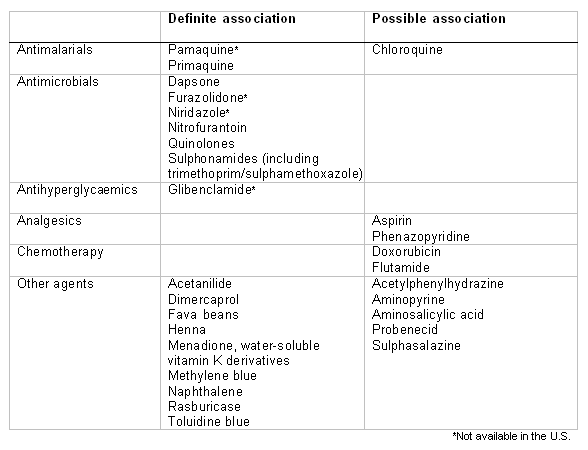History and exam
Key diagnostic factors
common
presence of risk factors
Key risk factors include male sex; family history of G6PD deficiency; African, Mediterranean, or Asian origin; recent exposure to drugs or broad beans; and recent infection.
jaundice
Indicates haemolytic anaemia.
Infants with class I G6PD deficiency may present with neonatal jaundice.[12]
pallor
Suggests anaemia.
dark urine
Suggests intravascular haemolysis.
Other diagnostic factors
common
nausea
Associated with haemolysis.
Risk factors
strong
male sex
G6PD is an X-linked condition and males are therefore affected far more commonly, and more severely, than females.
neonate
Neonatal jaundice is a common first presentation.
ethnic origin in the Mediterranean, sub-Saharan Africa, Middle East, or Southeast Asia
People from communities where malaria is or was common are at increased risk.
family history
Mother's male relatives will be affected, mother may have milder symptoms, and male siblings may be affected. However, as many patients (and family members) are asymptomatic, a positive family history may not be available. This should not exclude G6PD as a possible diagnosis.
recent exposure to oxidative drugs
Some drugs are known to pose an oxidative challenge to the red cells and to induce haemolytic anaemia in patients with G6PD deficiency.
For some drugs (e.g., dapsone, primaquine, sulphonamides), the association is very clear and consistent and haemolysis will be observed in virtually all patients, irrespective of residual enzyme activity.[2][12][13][14][25][26] For others (e.g., aspirin) the clinical association is less consistent and reflects an interplay of inherited (e.g., residual enzyme activity, pharmacokinetics) and acquired (e.g., dose, absorption and drug metabolism, co-existing infection) factors.[2][12][26] Topical therapy and domestic/cosmetic agents (e.g., naphthalene [mothballs] and henna) have also been implicated.[12][27][Figure caption and citation for the preceding image starts]: Drugs and agents that are known to cause haemolysis in people with G6PD deficiencyCreated by Professor Atul B. Mehta [Citation ends].
infection
Infection provokes an inflammatory response in which neutrophils are activated and oxidants, including hydrogen peroxide, are produced. This leads to an oxidative challenge to erythrocytes.
Bacterial (e.g., lobar pneumonia, typhoid) and viral (e.g., hepatitis) infections have been particularly implicated.
recent exposure to broad beans (favism)
Synonyms for fava beans include broad beans, fever beans, and English dwarf beans.
Favism is typically seen in boys with class II variants. It has also been reported in breast-fed G6PD-deficient infants of mothers who have eaten broad beans.
The toxic oxidative constituents of broad beans are divicine, isouramil, and convicine.[28]
Use of this content is subject to our disclaimer